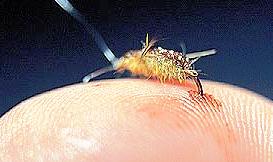On-stream Hook Removal
M*A*S*H Hook-removal Technique Works Well


Sooner or later you or a fishing buddy will sink a hook deeply into some
body part. You need a way to get the hook out without inflicting more
damage and pain. The following M*A*S*H hook-removal technique works
well and you may want to consider it if qualified medical help is not in
the boat beside you.
If the hook is in your butt and you are alone, you have a serious
problem and the technique will be of no use. (Unless you are a
contortionist.) But if you are with a friend or sink the hook into a
place you can reach with both hands this is a simple and relatively
painless way to yank out a hook with or without a barb. It works for
hooks of all sizes and is far less destructive to your body than the old
method of pushing the hook through and cutting off the barb. . .
aaarrggg!!
I've had the technique performed on me once, but I will confess outright
that I had the benefit of local freezing because the attending
emergency-room doctor refused to believe that this technique would work
without blood letting and pain. He insisted on freezing my finger first.
As it turns out the doctor apparently missed medical school the day they
covered "administering injection needles without pain." The damn needle
hurt more than sinking the barbed #16 hook into my finger, and I am
convinced it hurt way more than yanking the hook out unaided by pain
killer.
Despite having the benefit (???) of a local painkiller, I can assure the
technique works great. The small fly popped out in a fraction of a
second.

Here's what to do. First, leave the tippet or leader attached to the
hook and tie about a foot of fishing line or boot lace to the bend of
the hook as shown. Here's where you need at least two hands. Apply equal
pulling tension to both the leader and attached line, more or less
parallel to the hook shank. With a finger or thumb push down on the
shank. This is quite important as it prevents the barb (if using a
barbed hook) from tearing the flesh as the hook is removed.
The final stage is the tough one. (It's quick, but you or your friend
must have the courage to actually do it. My wife wimped out so I ended
up at the hospital where the doctor got to practice on me.) The line you
have tied to the bend is given a quick yank. It sounds rough, but it
actually works well. The hook should pop out without any flesh attached.
This May I was pike fishing alone in my pontoon boat. I was using a
large 8-inch streamer with a 3/0 stinger (trailer) hook
attached–something I have never done before and don't plan on using
again. (One downside of stinger hooks is that you sometimes forget they
are there. Then when you straighten and preen the hook materials the
stinger can give you a nasty jab.) Anyway, I landed a decent pike and
was in the process of removing the main hook from the toothy jaw and the
fish decided to squirm and wriggle. The loose 3/0 stinger hook jammed
hard and deep into the back of my left hand all the way to the base of
hook bend–nearly half an inch down past the side of the index finger
bone. I somehow managed to unhook and release the pike with the stinger
hook firmly imbedded in my hand. I did not (could not) use the entire
technique describe above. But I forced down on the hook shank as shown
in the diagrams and was able to pop out the hook more or less as shown–I
just never used the two lines. Thank God for barbless hooks.
I am not a medical doctor and am therefore not qualified to offer
medical advice. Use this, or any, procedure at your own risk. If you
bury a hook on your body you should seek professional attention if
possible. However, if you are miles from town you may want to give this
a try.
This week's closing thought is from
Alfred North Whitehead (1861-1947):
Every really new idea looks crazy at first.
Our Man In Canada Archives
Bio on Our Man In Canada

Clive Schaupmeyer is an outdoor writer and
photographer. He is the author of The Essential Guide to
Fly-Fishing, a 288-page book for novice and intermediate fly
anglers. His photo of a boy fishing was judged the best outdoor
picture of 1996 published by a member of the Outdoor Writers
of Canada. He fly-fishes for trout in Alberta's foothill and
mountain streams and for pike near his home in Brooks,
Alberta.
For information on where to find, or how to get a copy of
Clive's book, Click here!
|

 June 8th, 1998
June 8th, 1998



